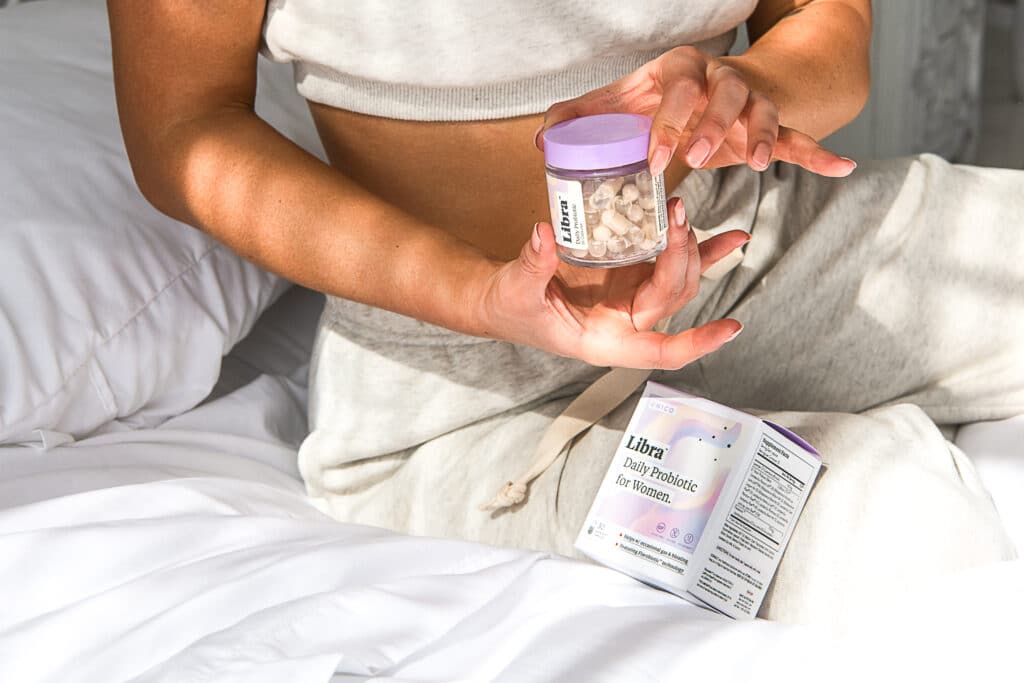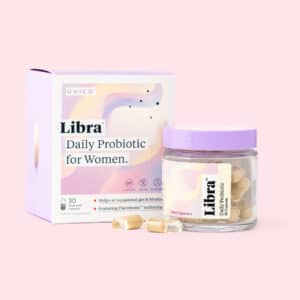“Probiotic strains, for a thousand, please!” shouted no one, ever. And there’s good reason why. With the hundreds of different strains, complete with long, hard-to-pronounce names, the bacteria-iffic world of probiotics can be incredibly daunting. Add in the thousands of probiotic product options, talk of AI-assisted stool analysis, and way too many uses of the word ‘microbiome’ in one single sentence, and you’re left with 10 billion CFUs of confusion. It’s time to clear things up a bit.

Let’s talk about your probiotic portfolio. After all, probiotics are quite a bit like stocks. There are a TON of options, and things can get confusing…but there’s also tremendous opportunity in them.
But…How do you know which stocks, (or ‘probiotics strains’ for our purposes), to add to your portfolio?
Well. By doing your homework!
And that’s the main goal of this article- to compile and share the most illuminating bits of the homework that helped guide which probiotics to include in our very own custom women’s blend, which was created by our partners at Lallemand FR, for exclusive use in our very own LIBRA Daily Probiotic for Women.
Because let’s face it – you do not want to venture into anything as complex and multi-faceted as stocks or gut bacteria without understanding what you are getting into…
And your gut microbiome can most certainly can be described as complex and multi-faceted.
So before we dive into our list of the top probiotic strains for women, let’s begin with some probiotic and gut health basics.
A Brief History of Probiotics.
‘Probiotics’ have actually been widely consumed in the form of fermented dairy products like yogurt for thousands of years. Throughout history various health benefits were noted from these foods, even though the science behind probiotics were not yet known.1
😎 Don’t Get it Confused: Probiotics are very different from ‘prebiotics’, which refer to a type of dietary fiber, which are also very important to overall gut health. Probiotics are also not to be confused with ‘synbiotics’ which are a marketing term referring to a product with both pre- and postbiotic components. A newer term, ‘postbiotic’ refers to a class of natural ingredients meant to mimic the output of probiotic activity. ‘Flavobiotics’ refer to the most-researched, and popular class of ‘postbiotics’.
The modern study of probiotic strains began in the early 1900s when Russian scientist, and future Nobel laureate Elie Metchnikoff began exploring the impact of Louis Pasteur’s ‘microorganisms responsible for the process of fermentation’ on human health, as opposed to Pasteur’s focus on food science.
In 1953, a German man named Werner Kollath coined the term ‘probiotic’ from greek words meaning ‘for life’.2
🧐 What Are Probiotics? Probiotics are live microorganisms which when administered in adequate amounts confer a health benefit on the host.
Today, the definition of probiotics is: “live microorganisms which when administered in adequate amounts confer a health benefit on the host.”
Probiotics are the living bacteria that comprise the ‘gut microbiome’. Probiotics are not only essential to healthy digestion, but several other areas of health as well. The study of the core microbiome has become increasingly intense as research proves probiotic strains to be more and more impactful on our health & well-being.
There are 7 main ‘genus’ of probiotic, with various species of each. The two-word names of probiotics are a combination of it’s ‘genus’ and ‘species’.
Typical Probiotic Naming Structure ⭢ Genus^ Bifidobacterium Species^ Animalis
The different genus / species probiotic combinations serve different roles in the gut, and body.
What Are the Benefits of Probiotics?
As mentioned, the study of probiotics has exploded in the past decade, as research uncovers even more fascinating roles that probiotics play. Among the most well-known benefits of probiotics, and having a healthy balance of ‘friendly’ gut bacteria are3:
- Maintaining a healthy immune system
- Promoting a healthy weight
- Avoiding digestive issues such as bloating, diarrhea, and constipation
- Keep cholesterol levels in check (+ overall cardiovascular health) 4
- Reducing susceptibility to allergies
- Preserving emotional health & well-being
The numerous, proven benefits of probiotics have led to a booming demand for probiotic supplements. Specific probiotic strains have also been shown to play critical roles in women’s health.
The Best Probiotic Strains for Women.
When it comes to women’s health, the most important probiotic genus is the lactobacillus family. Of the 50 different bacteria strains found naturally in the vagina, the majority are of the lactobacillus variety.
When the vagina’s healthy bacteria is not balanced, the risk of bacterial vaginosis (BV), yeast infections, trichomoniasis, and other complications is much higher.
So. Going back to our ‘Wall Street’ comparison – think of this like your own secret ‘probiotic’ tip-list. The research is there- and a LOT of it. So don’t waste another minute adding these to your daily ‘probiotic portfolio’, and watch your gut health wealth grow!
- Lactobacillus Acidophilus: This is the most researched probiotic strain regarding vaginal health. It has been scientifically-proven to reduce the risk of BV.5
- Lactobacillus Rhamnosus: This strain was actually shown to be more effective than antibiotics to treat symptoms of bacterial vaginosis!6
- Bifidobacterium Longum: One of the most fascinating strains is Bifidobacterium Longum – which is the focus of many ‘gut-brain’ connection research. This strain has shown promising results in combatting menopausal-related changes in mood, and even depression.7
- Bifidobacterium Lactis: A 2013 study in Jakarta showed that supplementing with this probiotic strain demonstrated significant improvement in intra-partum maternal gut health8. This strain also significantly reduces bloating and diarrhea.9
- Lactobacillus Casei: Rounding out our top 5 probiotic strains for women is Lactobacillus Casei – a powerful strain within the Lactobacillus family that reduces inflammation and improves overall digestive function. It is another strain with promising studies with all-female participants.10
6. *BONUS*: A postbiotic material like citrus flavonoids may increase the overall effectiveness of probiotics by lowering gut inflammation.11
Sources:
1https://journals.lww.com/jcge/fulltext/2016/11001/probiotics_history.3.aspx
2https://ods.od.nih.gov/factsheets/Probiotics-HealthProfessional
3https://pubmed.ncbi.nlm.nih.gov/11069570/
4https://pubmed.ncbi.nlm.nih.gov/22611376/
5https://pubmed.ncbi.nlm.nih.gov/8930233/
6https://pubmed.ncbi.nlm.nih.gov/16697231/
7https://gpsych.bmj.com/content/32/2/e100056
8https://pubmed.ncbi.nlm.nih.gov/28027638/
9https://pubmed.ncbi.nlm.nih.gov/27782892/
10https://onlinelibrary.wiley.com/doi/abs/10.1111/1756-185X.12333
11https://www.ncbi.nlm.nih.gov/pmc/articles/PMC6683056/
Recommended Reading:
- Holiday ‘Jingle Balls’ – A Festive Take on No-Bake Protein Balls - December 20, 2023
- Cryptic Cold Brew – A Must-Try for the Most Mischievous - October 31, 2023
- Does Protein Powder Make You Gain Weight? - October 4, 2022

